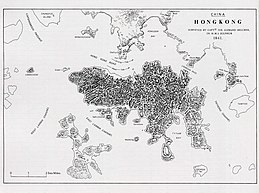Edward Belcher
Sir Edward Belcher Arctic Medal (1857) | |
|---|---|
| Spouse(s) | Diana Jolliffe |

Biography
Early life
Belcher was born in Halifax, Nova Scotia, the second son of Andrew Belcher and entered the Royal Navy in 1812.
Surveys
In 1825, he accompanied
On 25 January 1841, Commander Belcher landed on Possession Point at the north shore Hong Kong Island, and made the first British survey of Hong Kong harbour. After the war's end in 1842 he reached home and for his services was made a Knight Bachelor in the following year. He was then engaged on HMS Samarang, in surveying work in the East Indies, the Philippines, Port Hamilton, and other places, until 1847.[3]
Arctic expedition
In 1852 Belcher led the last and largest Admiralty expedition to attempt to find and rescue
He had five ships:
He left the
Another party went West and discovered Robert McClure, whose ship was frozen in at Mercy Bay. Belcher went north by sledge and found a channel at the northern tip of Devon Island, hinting that Franklin might have used it to escape to Baffin Bay. When the ice broke up that summer, he pushed his ships up Wellington Channel and became trapped again.
By February 1854, Belcher was becoming increasingly worried about the safety of his ships and men. In April he ordered Kellett to abandon his ships and return by sledge to North Star. Belcher abandoned his two ships in late July. Aided by two ships that showed up at Beechey Island (



He was exonerated, but his sword was returned to him "without observation". He never again received an active command. Curiously Resolute broke free of the ice and drifted all the way to
Despite his achievements, Belcher would later be described by a Hydrographer of the Navy as “a tyrannical martinet who made every ship he commanded a floating hell.”[5]
Later life
Following his last active service, Belcher was appointed Knight Commander of the Order of the Bath in 1867, and an admiral in 1872.[3]
Personal life
He was briefly married to Diana Jolliffe, stepdaughter of Captain Peter Heywood; that marriage ending upon her application for legal separation for his having infected her with venereal disease.[6]
Legacy
Belcher is commemorated in Hong Kong through
A highly venomous seasnake, Hydrophis belcheri, is also named in his honour.[7] Belcher collected the holotype which is housed in the Natural History Museum, London.
Works
- Treatise on Nautical Surveying (1835)
- Narrative of a Voyage Round the World (1843). (Vol. 1 / Vol. 2).
- Narrative of the Voyage of H.M.S. Samarang, During the Years 1843–46 (1848). (Vol. 1 / Vol. 2).
- The Last of the Arctic Voyages (1855). (Vol. 1 / Vol. 2).
- Horatio Howard Brenton (1856). (Vol. 1 / Vol. 2 / Vol. 3).
See also
Notes
- ^ "Obituary. Admiral Sir Edward Belcher, K.C.B." Proceedings of the Royal Geographical Society. 21: 410–416. 1877.
- ^ a b Ritchie, G.S. (1967). The Admiralty Chart. London: Hollis & Carter.
- ^ a b c d Chisholm 1911.
- ^ Roger, Blackley (1984). "Lance-Sergeant John Williams: Military Topographer of the Northern War". Art New Zealand no.32. pp. 50–53. Retrieved 24 December 2012.
- . Retrieved 22 April 2021.
- ^ Dictionary of Hong Kong Biography, Hong Kong University Press 2012, p. 24.
- ISBN 9781421401355. (Belcher, p. 22.)
References
- This article incorporates text from a publication now in the public domain: Chisholm, Hugh, ed. (1911). "Belcher, Sir Edward". Encyclopædia Britannica. Vol. 3 (11th ed.). Cambridge University Press. p. 663.
- Coleman, E. C. (2007). The Royal Navy and Polar exploration: from Franklin to Scott. Stroud: Tempus. ISBN 978-0-7524-4207-5.
- Alexander, Caroline (2003). The Bounty: The True Story of the Mutiny on the Bounty. New York: Viking. ISBN 0-670-03133-X.
External links
- Works by Edward Belcher at Biodiversity Heritage Library
- Works by Edward Belcher at Open Library
- Works by or about Edward Belcher at Internet Archive
- Edward Belcher Notebook, 1860 at Dartmouth College Library
